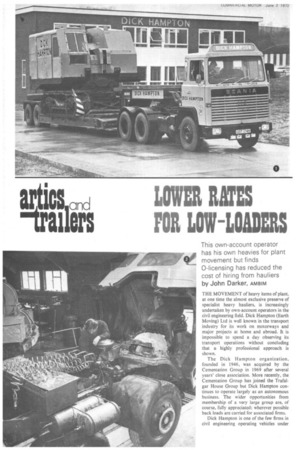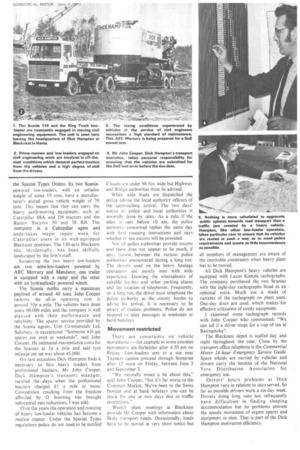LOWER RATES FOR LOW-LOADERS
Page 84

Page 85

If you've noticed an error in this article please click here to report it so we can fix it.
This own-account operator has his own heavies for plant movement but finds 0-licensing has reduced the cost of hiring from hauliers by John Darker, AMBIM THE MOVEMENT of heavy items of plant, at one time the almost exclusive preserve of specialist heavy hauliers, is increasingly undertaken by own-account operators in the civil engineering field. Dick Hampton (Earth Moving) Ltd is well known in the transport industry for its work on motorways and major projects at home and abroad. It is impossible to spend a day observing its transport operations without concluding that a. highly professional approach is shown.
T Dick Hampton organization, founded in 1946, was acquired by the Cementation Group in 1969 after several years' close association. More recently, the Cementation Group has joined the Trafalgar House Group but Dick Hampton continues to operate largely as an autonomous business. The wider opportunities from membership of a very large group are, of course, fully appreciated; wherever possible back loads are carried for associated firms.
Dick Hampton is one of the few firms in civil engineering operating vehicles under the Special Types Orders. Its two Scaniapowered low-loaders, with an unladen weight of some 19 tons, have a manufac turer's plated gross vehicle weight of 70 tons. This means that they can carry the heavy earth-moving equipment, such as Caterpillar 68A and 09 tractors and the Ruston Bucyrus 30 and 38 RB. The company is a Caterpillar agent and undertakes major repair work for Caterpillar users in its well-equipped Blacknest premises. The 130-acre Blacknest site. incidentally, has been skilfully landscaped by the firm's staff.
Supporting the two heavy low-loaders are two semi-low-loaders powered by AEC Mercury and Mandator, one trailer is equipped with a ramp and the other with an hydraulically powered winch.
The Scania outfits carry a maximum payload of around 40 tons. John Cooper reckons the all-in operating cost is around 50p a mile. The vehicles have done some 80.000 miles and the company is well pleased with their performance and reliability. The spares service provided by the Scania agents, Unit Commercials Ltd, Salisbury, is exceptional. "Someone will get spares out even at weekends", said John Cooper. He estimated maintenance costs for the Scanias at 3p a mile and said tyre mileage per set was about 45,000.
On rare occasions Dick Hampton finds it necessary to hire heavy loaders from professional hauliers. Mr John Cooper, Dick Hampton's transport manager, recalled the days when the professional hauliers charged Ell a mile or more. Competition resulting from the freedom afforded by 0 licensing has brought substantial rate reductions, I was told.
Over the years the operation and routeing of heavy low-loader vehicles has become a routine matter. Under the Special Types regulations police do not need to be notified
if loads are under 9ft 6in, wide but Highway and Bridge authorities must be advised.
When wide loads are dispatched the police advise the local authority officers of the approaching arrival. The two days' notice to police and local authorities is normally done by telex. As a rule, if the telex is sent before 10 am, the police authority concerned replies the same day with final routeing instructions and says whether or not escorts will be provided.
Not all police authorities provide escorts and there does not appear to be much, if any, liaison between the various police authorities encountered during a long run. The drivers used on the heavy haulage operations are mostly men with wide experience, knowing the whereabouts of suitable lay-bys and other parking places and the location of telephones. Frequently, on a long run, the driver must telephone the police authority at the county border to advise his arrival. It is necessary to be aware of routine problems. Police do not respond to telex messages at weekends or bank holidays
Movement restricted
There are constraints on vehicle movements — for example in some counties movements are forbidden after 4.30 pm on Friday. Low-loaders sent to a site near Taunton cannot proceed through Somerset after 12 noon on Friday, between June 2 and September 2.
We naturally moan a bit about this," said John Cooper, "but it's far worse in the Common Market. We've been to the Swiss frontier and at bank holidays you can be stuck for one or two days due to traffic restrictions."
Weekly plant meetings at Blacknest provide Mr Cooper with information about. likely transport needs. Occasionally, loads have to he moved at very short notice but
all members of management are aware of the inevitable constraints when heavy plant has to be moved.
All Dick Hampton's heavy vehicles are equipped with Lucas Kienzle tachographs. The company purchased the two Scanias with the eight-day tachographs fitted as an optional extra. Much use is made of variants of the tachograph on plant used. One-day discs are used, which makes for effective utilization of costly equipment.
1 examined some tachograph records with John Cooper who commented: "We can tell if a driver stops for a cup of tea at Basingstoke",
The Blacknest depot is staffed day and night throughout the year. Close by the transport office telephone is the Commercial Motor 29-hour Emergency Service Guide. Spare wheels are carried by vehicles and drivers carry the booklet of the National Tyre Distribution Association for emergency use.
Drivers' hours problems at Dick Hampton vary in relation to sites served. So far as possible drivers work a six-day week. Drivers doing long runs not infrequently have difficulties in finding sleeping accommodation but no problems prevent the speedy movement of urgent spares and equipment to sites. That is part of the Dick Hampton motivation efficiency.
















































































































































